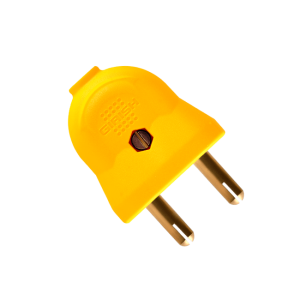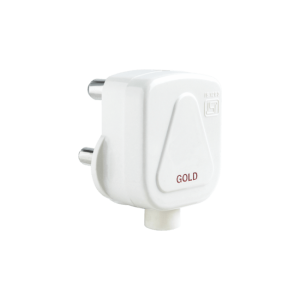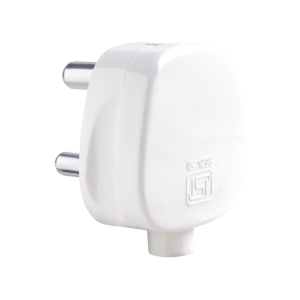What sets Girish Switches apart is our unwavering commitment to customer satisfaction. We understand the importance of reliable electrical connections in your daily life or business operations. That's why we invest in cutting-edge technology and skilled professionals to ensure that our plug tops not only meet but exceed your expectations. When you choose Girish Switches, you are choosing products that are built to last, withstand varying electrical loads, and deliver exceptional performance in any environment.
Our two-pin plug tops are ideal for everyday household appliances, providing a secure and stable connection for your devices. For more complex setups, our three-pin plug tops offer enhanced grounding and compatibility, ensuring the safe operation of your electronics. Additionally, our male-female plug tops provide versatility, allowing you to create custom extension cords tailored to your specific needs. Whether you are setting up a home office or a commercial space, Girish Switches has the right solution for you.
For industrial applications, our 6 amp. and 16 amp. plug tops are engineered to handle heavy electrical loads with ease. These plug tops are built to withstand demanding environments, making them perfect for workshops, factories, construction sites, and more. With Girish Switches, you can trust that your equipment will remain powered and operational, even in challenging conditions.
In addition to our exceptional product range, Girish Switches prides itself on outstanding customer service. Our knowledgeable and friendly team is always ready to assist you with product selection, installation guidance, and any queries you may have. We believe in building lasting relationships with our customers, based on trust, reliability, and unmatched quality.
When you choose Girish Switches, you are choosing reliability, durability, and safety. Experience the difference of high-quality plug tops tailored to your unique requirements. Trust Girish Switches for all your electrical needs, and let us power your world with excellence.
All You Need to Know About Two Pin and Three Pin Plugs
In many places of the world, the three-pin plugs indicate that the appliances are made to be grounded. The purpose of the three-pin plugs is usually seen as that but what does it truly entail? People often wonder if grounding is so much needed for safety, why do even some appliances come with the 2 pin plug instead of three pins? Not to mention, the questions are endless in the minds of the users. This is why there is some information presented related to two-pins and three-pin plugs that you should know. Also, it would help you to make the right purchase accordingly.
What is an Electrical Plug?
Electrical plugs also referred to as power plugs and are the objects in charge of sending and receiving current from a receptacle to the electrical appliance's circuit.
There are pins supported by plastic support or case which make up electrical plugs. When connecting an appliance to the main power source electrically, the 2 pin plug or the three-pin plug is placed into the holes of an outlet.
On the other hand, if you look around you would find a variety of common electrical connectors used in homes, businesses, and other establishments, especially from leading manufacturers and suppliers like Girish Switches.
Types of Electrical Plugs Commonly Used
Basically, there are two types of electrical plugs which are commonly used. And they are two and three-pin plugs. If you want to know more about them, then read the next part.
● Two Pin Plugs
One pin from a 2-pin plug is attached to the "hot" and "neutral" slots of the outlet, respectively. The hot slot of the socket is joined to the hot pin. It pulls current from the outlet and that currently powers the load.
The neutral pin, which is attached to the neutral slot of the socket, allows the current to flow back to the power source and into the outlet. Two-slot receptacles are known to be the ones that easily accept two-pronged plugs.
However, make sure to buy 2 pin plug from brands like Girish Switches that ensure stability as well as durability.
● Three Pin Plugs
A grounding or earthing pin is added to three-pronged connectors. The ground wire of an electrical system is attached to this pin.
It usually lies between the hot and neutral pins. The ground connection is a precautionary measure as this pin does not carry current.
The ground connection will convey and neutralise any stray electricity to the power supply and the ground in the event of a bad wire, short circuit, or electrical surge.
Thus, the ground connection can shield users from electric shock, electrical fires, and plugged-in appliance damage.
Additionally, three-slot receptacle installation is now necessary for newly constructed homes and buildings. High-power electrical appliances including flat irons, toasters, HVAC systems, heavy machinery, and other delicate devices utilize three-pin plugs from brands like Girish Switches.
Depending on the needs of an electrical device, the use of both 2-pin plugs and 3-pin plugs is seen.
The performance of ground connection in a circuit with a two-pin plug is inferior to that of a third pin.
This is the rationale behind the third pin's inclusion, which controls the ground current to protect the user. Therefore to know the uses of the pins, check out below.
Uses for Plugs with 3 and 2 Pins:
● Three Pin Plug
This particular style of 3-pin top plug is intended specifically for use with class III electrical devices including refrigerators, microwaves, and other metal-bodied appliances.
To prevent electrocution from leakage of electricity onto the metal body, all of these appliances must be earthed or grounded.
Not to mention, the three-pin plugs from Girish Switches provide more safety against insulation failures compared to 2 pin plugs.
● Two Pin Plug
Typically, class II electrical goods like TVs and internet routers are powered by 2 pin plugs. Any low-power-consuming electrical or electronic equipment can be connected to electricity using a simple 2-pin plug connector.
What are the Differences that the 2 Pin Plug and 3 Pin Plug Share?
As mentioned earlier, people often wonder why some modern home appliances have three-pin plugs and others have only two. Well, basically because there is a big difference between these two plugs. And to know about them, you are suggested to read below.
● Grounding
Some plugs have three pins because they are "grounded," which is the rationale for this. This indicates that the third pin is directly connected to the outside ground via a network of wires.
It is safer to have the electricity grounded outdoors rather than inside your home in case of an electrical issue because doing so could start a fire.
● Cutting the Third Pin
The 3rd pin of an electrical plug should be left connected to the wire, according to the majority of electricians. It is placed there to keep you safe. Even though getting past it can be a bother - leaving it in place is significantly safer.
● Two Pins
In general, devices lacking three pins do not require enough electricity to necessitate a ground. A failure with these electronics would only give you a moderate shock, even in the worst-case situation.

































